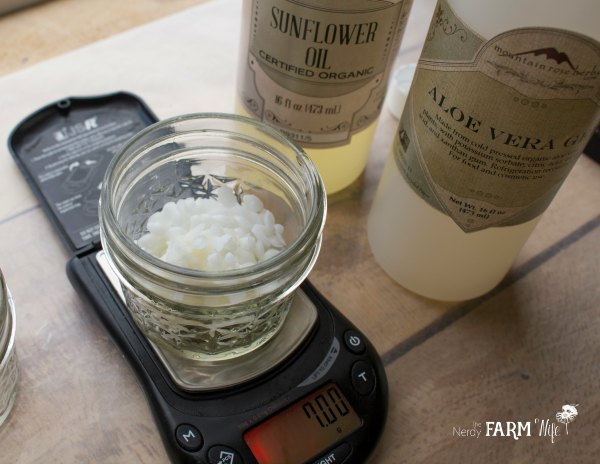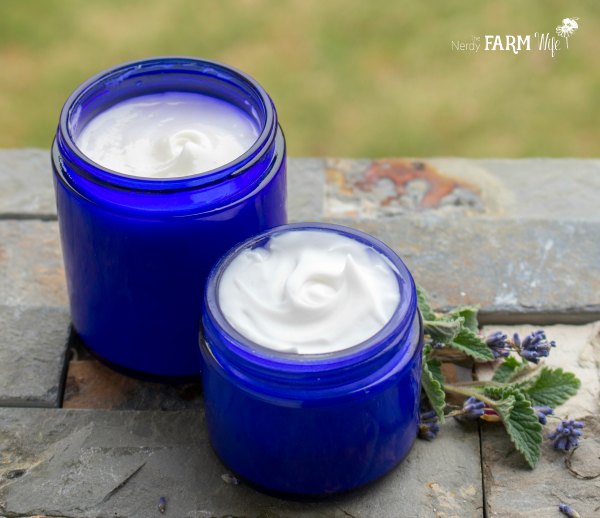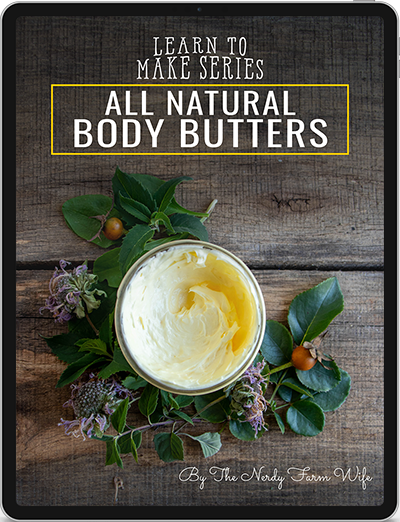2 Gentle Homemade Lotion Recipes for Sensitive Skin

In my last blog post, I mentioned that I’d received several requests for gentle homemade lotion and soap recipes that would be suitable for extra sensitive skin, especially when it’s caused by cancer treatments.
I shared some extra gentle soap recipes in that article, and today will cover lotions.
There are two different recipes options provided below, yielding two different types of lotions.
(Remember, these are just my recipe suggestions, not to replace the advice of a professional healthcare provider.)
Emulsifying Wax vs Beeswax
The first recipe is made with vegetable emulsifying wax (I always use THIS KIND), which makes creating your own lotions a breeze.
Since it can support a higher amount of water, lotion made with e-wax has a lighter texture and sinks into your skin more easily.
The second option uses beeswax instead, for my readers who don’t want to use emulsifying wax.
Since beeswax isn’t a true emulsifier (unless you combine it with borax/sodium borate), it’s trickier to get a lotion to turn out right, but it can be done!
Lotion made with beeswax will be richer and oilier than one made with emulsifying wax and you’ll likely notice some separation over time. (When this happens, stir briskly with a fork to reincorporate.)

Ingredients & Why I Chose Them
- Sunflower Oil – This is one of my favorite oils because its great for all skin types and especially helpful for those with sensitive, fragile or damaged skin. You could also use sweet almond, hemp, avocado, apricot kernel, jojoba or your favorite oil instead.
- Shea or Mango Butter – Emollients that help give the lotion a creamier feel, protects skin and offers anti-inflammatory properties.
- Aloe Vera Gel – This therapeutic ingredient is often recommended to help soothe and reduce skin inflammation. If you can’t use aloe, replace it with more distilled water instead.
- Distilled Water – This is recommended since tap water can contain unwanted contaminants and bacteria. Check the bottled water section of local grocery stores.
- Beeswax – This ingredient is only found in lotion #2. It helps thicken lotion and creates a barrier to help protect skin.
- Vegetable Emulsifying Wax – This ingredient is only found in lotion #1. It makes it so oil and water easily mix together.
- Preservative – This is needed to keep bacteria or mold from growing in your lotion. I have some options listed near the bottom of this article.

Gentle Homemade Lotion for Sensitive Skin {with emulsifying wax}
This version requires an accurate digital scale to make.
Ingredients
- 18 g sunflower (or other) oil
- 12 g shea or mango butter
- 7 g emulsifying wax
- 40 g aloe vera gel
- 33 g distilled water
- preservative of choice (see below)
Directions to Make
- Weigh the distilled water and aloe in a heatproof container.
- Weigh the sunflower oil, shea butter and vegetable emulsifying wax in a separate heatproof container. (I use two small 4 oz jelly/canning jars.)
- Place both jars down into a saucepan containing a couple inches of water, forming a double boiler of sorts.
- Turn the burner to medium low and heat until the wax is fully melted – about 10 to 15 minutes.
- Pour the hot water/aloe and melted wax/butter/oil together into a clean jar and stir briskly with a fork for several minutes.
- Stir frequently until the lotion starts to thicken as it cools. I usually place the container down into a bowl of ice water to help speed this step up.
- Once cool enough for your preservative of choice, stir that in and mix well.
- Pour into lotion containers or jars.
* There are many choices when it comes to preservatives. I currently like Leucidal SF Complete (ECOCERT/COSMOS approved, Lactobacillus & coconut ferment) used at 4% (or 4 grams in this recipe).
Please see my article: 10 Natural Preservatives for Homemade Skin Care for more options.
Gentle Homemade Lotion for Sensitive Skin {with beeswax}
A scale is highly recommended, but volume equivalents are given if you don’t have one available.
This recipe is an adapted variation of Rosemary Gladstar’s famous Perfect Cream Recipe, found in her wonderful book Medicinal Herbs, A Beginner’s Guide.
Ingredients
- 1/4 + 1/8 cup (2.55 oz / 73 g) sunflower oil
- 1/8 cup (0.9 oz / 25 g) shea or mango butter
- 1/2 Tbsp beeswax pastilles, heaped (5 g)
- 1/4 cup (1.7 oz / 48 g) aloe vera gel
- 1/4 cup (2.1 oz / 60 g) distilled water
- preservative of choice (see below*)
Directions to Make
- Melt the oil, butter and beeswax in a heatproof container. (I use a pyrex measuring cup.)
- Place the container into a saucepan filled with a few inches of water, forming a double boiler of sorts.
- Heat over a medium-low burner until the beeswax is completely melted. (About 20 – 25 minutes.)
- Remove from heat and let cool at room temperature for 10 minutes, then move to the refrigerator for an additional 15 to 20 minutes.
- While the oil/butter/wax mixture is cooling, measure the aloe and water into a heatproof jar or container.
- During the last 5 to 10 minutes that the oil/butter/wax mixture is cooling, place the aloe/water container into the saucepan and heat on low.
- Warm the aloe/water and chill the oil/butter/wax mixture until they’re around 90 degrees F. It’s important that both mixtures are within 5 degrees F of each other.
- Using a handheld mixer, start mixing the oil/butter/wax mixture while slowly drizzling in the aloe/water.
- Turn the speed to medium-high and beat for about 4 or 5 minutes, forming a lovely creamy looking lotion.
- Add your preservative of choice and blend for another half-minute to make sure it’s completely incorporated.
- Pour into jars or bottles.
* There are many choices when it comes to preservatives. I currently like Leucidal SF Complete (ECOCERT/COSMOS approved, Lactobacillus & coconut ferment) used at 4% (or 8.5 grams in this recipe). Please see my article: 10 Natural Preservatives for Homemade Skin Care for more options.



Thank you for explaining the difference between beeswax and e-wax :)
Hi Liz! I’m glad you found it helpful! :)
Question which I can not find the answer to after searching extensively…. does any of the preservatives actions transfer to our skin, the largest organ we have with its own microbiome? This is a question that needs an answer because then the question becomes one of risk/benefit. Our skin is fully capable of defending against bacteria but only if we stop destroying it. Have you seen anything about this? Thank you. I’ve never gotten even a response when I’ve asked this question.
Hi Jennifer, That’s a great question & very thought provoking! I was just recently reading this article on how the skin’s microbiome may even protect against melanoma: http://ucsdnews.ucsd.edu/pressrelease/beneficial_skin_bacteria_protect_against_skin_cancer
and I know it’s a factor in eczema too, so it makes sense that you don’t want to disrupt the ‘good guys’ with certain preservatives in lotions/creams.
Not having done any specific research on that particular line of thinking, my first train of thought is that just like how powerful antibiotics can wipe out good guys in your gut, and probiotics can build them back up – you have super strong preservatives with warning labels about skin irritation (like liquid germall plus) that are very effective at what they do, but might be more disruptive in the process (although they’re often used in super teeny amounts); and then you have mild nature-derived options, like the ones I prefer that often require larger amounts used & aren’t as long lasting/effective.
Two examples of mild preservatives are: Phytocide Aspen Bark, which can condition and smooth skin, and NataPres which can be helpful for acne – this seems to indicate they bring benefits (sort of like thyme or calendula) & I’ve not read of any risks associated with them to date.
So I guess that’s a long rambly way of saying I’m not really sure either, but I’ll definitely think on it more & keep it in mind while I’m doing future research.
Thanks for asking such a great question! :)
Thank you for the response! I am going to keep researching. This question just bugs me as no one seems to have a answer. But, science is just “discovering” the many microbiomes we have and their importance to our lives. I have always thought if we are putting an antimicrobial on say an arm prolly no problem but when we slather lotion on our entire bodies everyday possibly more than once then what are the consequences of even a small amount of antimicrobial. I may never find an answer to this question. ?
Thanks again and thanks for the 2 gentler preservatives you mentioned.
I’d love to hear how your research goes, if you get a chance to come back & update us. It’s very interesting!
Thank you very Much Jan for all your explanations, I love to recive your mail every month but I also love reading your books, because all the recipes are so interesting and I learn about all herbs witch are growing in my garden….So, I’m very happy.
Thank you, JOËLLE
Hi Joëlle! I’m so happy to hear that you’re enjoying the emails, books & recipes! :)
Hi. I’m on the lookout for a hand cream. I’m hoping it won’t need water, which also makes me hope that I won’t need to add a preservative. Are there particular botanicals, essential oils, or other ingredients that might naturally preserve my hand cream? I would like to make very small amounts, mostly just for my own use, so I don’t need a long shelf life. Thanks!
Hi Janet! You might like a whipped butter to use as a hand cream.
Here’s a recipe you may enjoy:
https://thenerdyfarmwife.com/wild-rose-body-butter/
It doesn’t have to be rose scented, you can just use the oil/butter amounts and scent it however you’d like.
I’ve made that recipe with lemongrass before & it was well received by family & friends, or you could add lavender or even leave it unscented if you’d like!
Since it doesn’t have water, it won’t need a preservative, and it will still stay fresh for many months. :)
Hi Jan! I just love your recipes and your site and I am learning so much! Question. What is the shelf life on this product? Would you still recommend refridgerating with the added preservative or can it be kept in a cool, dark place like you suggest for other DIY skincare products?
Hi Chrissy! I’m so happy to hear you’re enjoying the recipes & site! :)
If you don’t add a preservative, then I’d keep it in the fridge & use within 2 weeks.
If you add a preservative, you won’t need to refrigerate it, but a cool dark place is a great idea. Someplace with high humidity & fluctuating heat (like a bathroom) isn’t a good spot & could affect shelf life.
For nature-derived preservatives (such as one of the Leucidal products, NataPres, Phytocide preservatives) then I usually get at least 2 to 3 months shelf life, though it varies & they have to be watched more closely.
If you use something stronger like Liquid Germall Plus, then it will last for a long time – probably well over a year.
Hello, and thank you for all you do!! I am curiou how much of the Leucidal SF Complete preservative I use for this recipe?
Hi San! I use it at 4%. So for the first recipe you’d need 4 grams, and for the second recipe, you would use 8.5 grams. :)
Hi Jan, first off.. thank you for all your amazing recipes and for taking the time to post them all with so much detail and info. I love seeing your email show up in my inbox :) I just made this cream I made the one with ewax it turned out great! It’s very light I doubled the recipe after I discovered how little 18 grams of oil was..lol. I used plantane infused sunflower oil and at the end, after I decided it was as fluffy as it was going to get I added four drops of lavender oil. It’s wonderful! Thank you!
Hi Nicole, Thank you for the kind words! I’m so happy you enjoy the recipes & emails! :) I’m very glad you like the lotion recipe too!
This sounds like a lovely recipe. Could you tell approximately how long this lotion would last?
Hi Tayla! It will depend a lot on what type of preservative you use.
I have more detail about shelf life in my article on natural preservatives:
https://thenerdyfarmwife.com/natural-preservatives-for-skin-care/
If you still have questions after reading that, just let me know & I’m happy to help! ❤
Would it be reasonable to use a hydrosol in place of distilled water?
Hi Ingeborg! Yes, you can use hydrosols in place of distilled water in lotions.
I normally use part water/part hydrosol in that case. :)